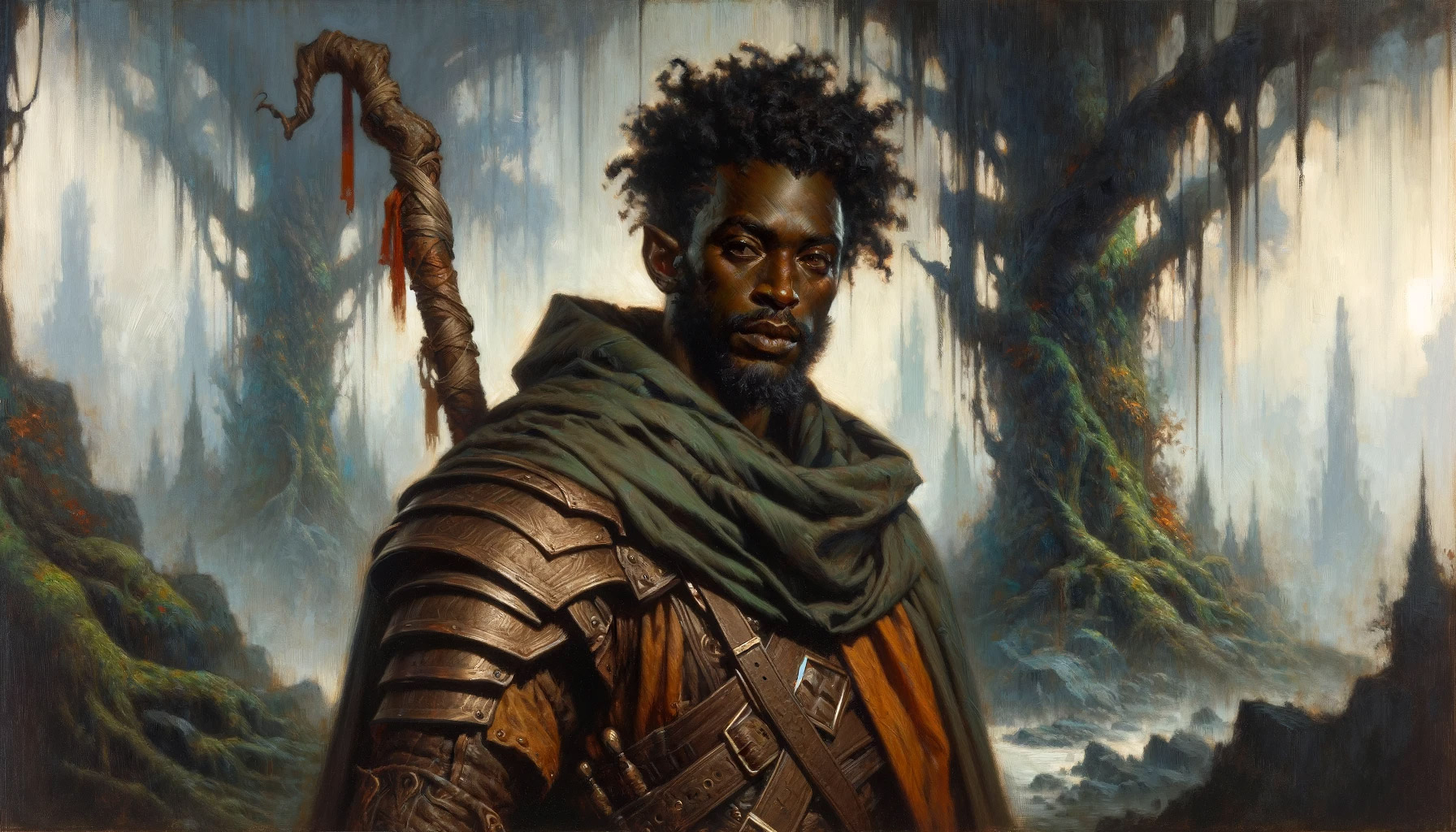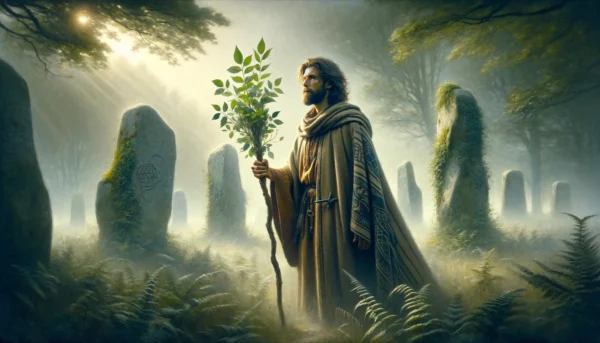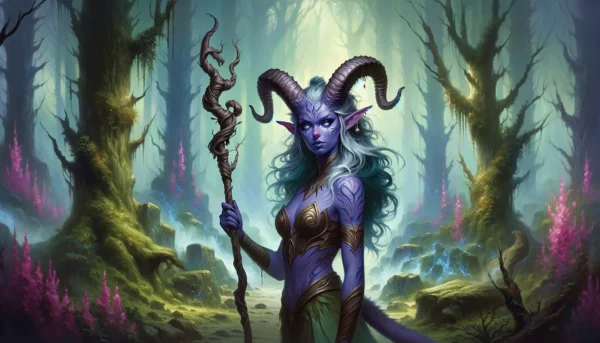
Druid
Druid
Druids are guardians of nature and its primal forces, tapping into the ancient magic that flows through the natural world. These wise and mystic individuals have a deep connection to the elements, plants, and animals, granting them unique abilities to shape-shift, commune with nature, and cast spells. Embracing their role as protectors, druids can transform into various animal forms, granting them versatility in combat and allowing them to explore environments with enhanced senses. They wield potent nature-based magic, capable of healing wounds, summoning creatures, and manipulating the elements to both aid allies and hinder enemies. Respecting the balance of the natural order, druids advocate for ecological harmony and stand against those who threaten it. Through their reverence for nature’s wonders, druids offer a profound understanding of the world’s interconnectedness, serving as stewards of the wild and defenders of its sanctity.
Class Features
As a druid, you gain the following features.
Hit Points
Proficiencies
Armor: Light Armor, Medium Armor, Shield. Druids will not wear armor or use shields made of metal
Weapon: Clubs, daggers, darts, javelins, maces, quarterstaffs, scimitars, sickles, slings, spears
Tool: Herbalism kit
Saving Throw: Intelligence, Wisdom
Skills: You have 2 of the following skills: Animal Handling, Arcana, Insight, Medicine, Nature, Perception, Religion, Survival.
Starting Gold
You start with 2d4 x 10 gold pieces (GP) unless you choose to take the equipment below
Starting Equipment
You start with the following equipment, in addition to the equipment granted by your background:
- (a) shield or (b) any simple weapon
- (a) scimitar or (b) any simple melee weapon
- (a) any druidic foci
- leather armor
- explorer's pack
Druid Features Table
| LVL | Pro+ | Features | Cantrips Known | Spell Slots per Spell Level | ||||||||
|---|---|---|---|---|---|---|---|---|---|---|---|---|
| 1st | 2nd | 3rd | 4th | 5th | 6th | 7th | 8th | 9th | ||||
| 1st | +2 | Druidic, Spellcasting | 2 | 2 | – | – | – | – | – | – | – | – |
| 2nd | +2 | Wild Shape, Druid Circle, Druid Circle Feature | 2 | 3 | – | – | – | – | – | – | – | – |
| 3rd | +2 | – | 2 | 4 | 2 | – | – | – | – | – | – | – |
| 4th | +2 | Wild Shape Improvement, Ability Score Improvement | 3 | 4 | 3 | – | – | – | – | – | – | – |
| 5th | +3 | – | 3 | 4 | 3 | 2 | – | – | – | – | – | – |
| 6th | +3 | Druid Circle Feature | 3 | 4 | 3 | 3 | – | – | – | – | – | – |
| 7th | +3 | – | 3 | 4 | 3 | 3 | 1 | – | – | – | – | – |
| 8th | +3 | Wild Shape Improvement, Ability Score Improvement | 3 | 4 | 3 | 3 | 2 | – | – | – | – | – |
| 9th | +4 | – | 3 | 4 | 3 | 3 | 3 | 1 | – | – | – | – |
| 10th | +4 | Druid Circle Feature | 4 | 4 | 3 | 3 | 3 | 2 | – | – | – | – |
| 11th | +4 | – | 4 | 4 | 3 | 3 | 3 | 2 | 1 | – | – | – |
| 12th | +4 | Ability Score Improvement | 4 | 4 | 3 | 3 | 3 | 2 | 1 | – | – | – |
| 13th | +5 | – | 4 | 4 | 3 | 3 | 3 | 2 | 1 | 1 | – | – |
| 14th | +5 | Druid Circle Feature | 4 | 4 | 3 | 3 | 3 | 2 | 1 | 1 | – | – |
| 15th | +5 | – | 4 | 4 | 3 | 3 | 3 | 2 | 1 | 1 | 1 | – |
| 16th | +5 | Ability Score Improvement | 4 | 4 | 3 | 3 | 3 | 2 | 1 | 1 | 1 | – |
| 17th | +6 | – | 4 | 4 | 3 | 3 | 3 | 2 | 1 | 1 | 1 | 1 |
| 18th | +6 | Timeless Body, Beast Spells | 4 | 4 | 3 | 3 | 3 | 3 | 1 | 1 | 1 | 1 |
| 19th | +6 | Ability Score Improvement | 4 | 4 | 3 | 3 | 3 | 3 | 2 | 1 | 1 | 1 |
| 20th | +6 | Archdruid | 4 | 4 | 3 | 3 | 3 | 3 | 2 | 2 | 1 | 1 |
Class Features at Level
Druidic
You know Druidic, the secret language of druids. You can speak the language and use it to leave hidden messages. You and others who know this language automatically spot such a message. Others spot the message’s presence with a successful DC 15 Wisdom (Perception) check but can’t decipher it without magic.
Spellcasting
Drawing on the divine essence of nature itself, you can cast spells to shape that essence to your will.
Cantrips
At 1st level, you know two cantrips of your choice from the druid spell list. You learn additional druid cantrips of your choice at higher levels, as shown in the Cantrips Known column of the Druid table.
Preparing and Casting Spells
The Druid table shows how many spell slots you have to cast your spells of 1st level and higher. To cast one of these druid spells, you must expend a slot of the spell’s level or higher. You regain all expended spell slots when you finish a long rest.
You prepare the list of druid spells that are available for you to cast, choosing from the druid spell list. When you do so, choose a number of druid spells equal to your Wisdom modifier + your druid level (minimum of one spell). The spells must be of a level for which you have spell slots.
For example, if you are a 3rd-level druid, you have four 1st-level and two 2nd-level spell slots. With a Wisdom of 16, your list of prepared spells can include six spells of 1st or 2nd level, in any combination. If you prepare the 1st-level spell cure wounds, you can cast it using a 1st-level or 2nd-level slot. Casting the spell doesn’t remove it from your list of prepared spells.
You can also change your list of prepared spells when you finish a long rest. Preparing a new list of druid spells requires time spent in prayer and meditation: at least 1 minute per spell level for each spell on your list.
Spellcasting Ability
Wisdom is your spellcasting ability for your druid spells, since your magic draws upon your devotion and attunement to nature. You use your Wisdom whenever a spell refers to your spellcasting ability. In addition, you use your Wisdom modifier when setting the saving throw DC for a druid spell you cast and when making an attack roll with one.
Spell save DC = 8 + your proficiency bonus + your Wisdom modifier.
Spell attack modifier = your proficiency bonus + your Wisdom modifier.
Ritual Casting
You can cast a druid spell as a ritual if that spell has the ritual tag and you have the spell prepared.
Spellcasting Focus
You can use a druidic focus (see chapter 5, “Equipment”) as a spellcasting focus for your druid spells.
Wild Shape
You can use your action to magically assume the shape of a beast that you have seen before. You can use this feature twice. You regain expended uses when you finish a short or long rest.
Your druid level determines the beasts you can transform into, as shown in the Beast Shapes table. At 2nd level, for example, you can transform into any beast that has a challenge rating of 1/4 or lower that doesn’t have a flying or swimming speed.
Beast Shapes
| Level | Max. CR | Limitations | Example |
|---|---|---|---|
| 2nd | 1/4 | No flying or swimming speed | Wolf |
| 4th | 1/2 | No flying speed | Crocodile |
| 8th | 1 | — | Giant eagle |
You can stay in a beast shape for a number of hours equal to half your druid level (rounded down). You then revert to your normal form unless you expend another use of this feature. You can revert to your normal form earlier by using a bonus action on your turn. You automatically revert if you fall unconscious, drop to 0 hit points, or die.
While you are transformed, the following rules apply:
- Your game statistics are replaced by the statistics of the beast, but you retain your alignment, personality, and Intelligence, Wisdom, and Charisma scores. You also retain all of your skill and saving throw proficiencies, in addition to gaining those of the creature. If the creature has the same proficiency as you and the bonus in its stat block is higher than yours, use the creature’s bonus instead of yours. If the creature has any legendary or lair actions, you can’t use them.
- When you transform, you assume the beast’s hit points and Hit Dice. When you revert to your normal form, you return to the number of hit points you had before you transformed. However, if you revert as a result of dropping to 0 hit points, any excess damage carries over to your normal form. For example, if you take 10 damage in animal form and have only 1 hit point left, you revert and take 9 damage. As long as the excess damage doesn’t reduce your normal form to 0 hit points, you aren’t knocked unconscious.
- You can’t cast spells, and your ability to speak or take any action that requires hands is limited to the capabilities of your beast form. Transforming doesn’t break your concentration on a spell you’ve already cast, however, or prevent you from taking actions that are part of a spell, such as call lightning, that you’ve already cast.
- You retain the benefit of any features from your class, race, or other source and can use them if the new form is physically capable of doing so. However, you can’t use any of your special senses, such as darkvision, unless your new form also has that sense.
- You choose whether your equipment falls to the ground in your space, merges into your new form, or is worn by it. Worn equipment functions as normal, but the GM decides whether it is practical for the new form to wear a piece of equipment, based on the creature’s shape and size. Your equipment doesn’t change size or shape to match the new form, and any equipment that the new form can’t wear must either fall to the ground or merge with it. Equipment that merges with the form has no effect until you leave the form.
Druid Circle
You choose to identify with a circle of druids, such as the Circle of the Land. Your choice grants you features at 2nd level and again at 6th, 10th, and 14th level.
Druid Circle Feature
Your Druid Circle grants you abilities at this level.
Wild Shape Improvement
You can transform into any beast that has a challenge rating of 1/2 or lower that doesn’t have a flying speed.
Ability Score Improvement
You can increase one ability score of your choice by 2, or you can increase two ability scores of your choice by 1. As normal, you can’t increase an ability score above 20 using this feature. Alternatively, you can choose to take one Feat instead of the ability score increase.
Druid Circle Feature
Your Druid Circle grants you abilities at this level.
Wild Shape Improvement
You can transform into any beast that has a challenge rating of 1 or lower.
Ability Score Improvement
You can increase one ability score of your choice by 2, or you can increase two ability scores of your choice by 1. As normal, you can’t increase an ability score above 20 using this feature. Alternatively, you can choose to take one Feat instead of the ability score increase.
Druid Circle Feature
Your Druid Circle grants you abilities at this level.
Ability Score Improvement
You can increase one ability score of your choice by 2, or you can increase two ability scores of your choice by 1. As normal, you can’t increase an ability score above 20 using this feature. Alternatively, you can choose to take one Feat instead of the ability score increase.
Druid Circle Feature
Your Druid Circle grants you abilities at this level.
Ability Score Improvement
You can increase one ability score of your choice by 2, or you can increase two ability scores of your choice by 1. As normal, you can’t increase an ability score above 20 using this feature. Alternatively, you can choose to take one Feat instead of the ability score increase.
Timeless Body
The primal magic that you wield causes you to age more slowly. For every 10 years that pass, your body ages only 1 year.
Beast Spells
You can cast many of your druid spells in any shape you assume using Wild Shape. You can perform the somatic and verbal components of a druid spell while in a beast shape, but you aren’t able to provide material components.
Ability Score Improvement
You can increase one ability score of your choice by 2, or you can increase two ability scores of your choice by 1. As normal, you can’t increase an ability score above 20 using this feature. Alternatively, you can choose to take one Feat instead of the ability score increase.
Archdruid
You can use your Wild Shape an unlimited number of times.
Additionally, you can ignore the verbal and somatic components of your druid spells, as well as any material components that lack a cost and aren’t consumed by a spell. You gain this benefit in both your normal shape and your beast shape from Wild Shape.
Sacred Plants and Wood
A druid holds certain plants to be sacred, particularly alder, ash, birch, elder, hazel, holly, juniper, mistletoe, oak, rowan, willow, and yew. Druids often use such plants as part of a spellcasting focus, incorporating lengths of oak or yew or sprigs of mistletoe.
Similarly, a druid uses such woods to make other objects, such as weapons and shields. Yew is associated with death and rebirth, so weapon handles for scimitars or sickles might be fashioned from it. Ash is associated with life and oak with strength. These woods make excellent hafts or whole weapons, such as clubs or quarterstaffs, as well as shields. Alder is associated with air, and it might be used for thrown weapons, such as darts or javelins.
Druids from regions that lack the plants described here have chosen other plants to take on similar uses. For instance, a druid of a desert region might value the yucca tree and cactus plants.
Druids and the Gods
Some druids venerate the forces of nature themselves, but most druids are devoted to one of the many nature deities worshiped in the multiverse (the lists of gods in appendix PH- B include many such deities). The worship of these deities is often considered a more ancient tradition than the faiths of clerics and urbanized peoples.
Druid Circle
Druid Circles are subgroups or orders within the druidic tradition, each focusing on a specific aspect of nature or a particular philosophy. When a druid reaches 2nd level, they choose to join one of these Circles, which guides their future development and grants them unique abilities related to their chosen focus.
Circle of the Eternal Flame
Circle of the Land
Circle of the Mirage
Druid Spells
Credits: SRD 5.1


